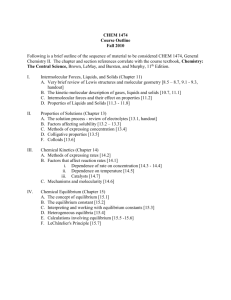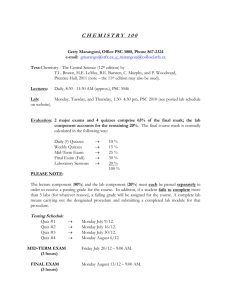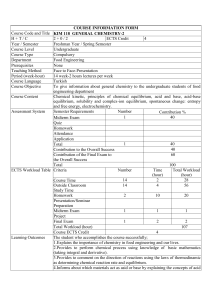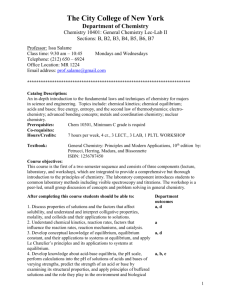Salame - The City College of New York
advertisement
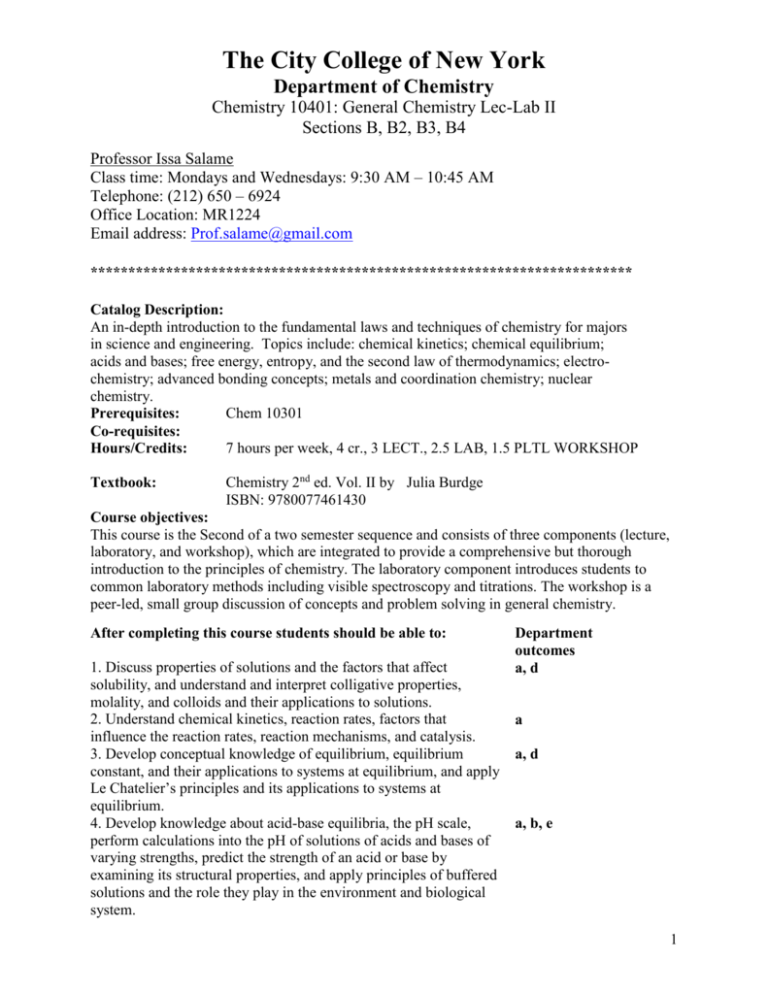
The City College of New York Department of Chemistry Chemistry 10401: General Chemistry Lec-Lab II Sections B, B2, B3, B4 Professor Issa Salame Class time: Mondays and Wednesdays: 9:30 AM – 10:45 AM Telephone: (212) 650 – 6924 Office Location: MR1224 Email address: Prof.salame@gmail.com ************************************************************************ Catalog Description: An in-depth introduction to the fundamental laws and techniques of chemistry for majors in science and engineering. Topics include: chemical kinetics; chemical equilibrium; acids and bases; free energy, entropy, and the second law of thermodynamics; electrochemistry; advanced bonding concepts; metals and coordination chemistry; nuclear chemistry. Prerequisites: Chem 10301 Co-requisites: Hours/Credits: 7 hours per week, 4 cr., 3 LECT., 2.5 LAB, 1.5 PLTL WORKSHOP Textbook: Chemistry 2nd ed. Vol. II by Julia Burdge ISBN: 9780077461430 Course objectives: This course is the Second of a two semester sequence and consists of three components (lecture, laboratory, and workshop), which are integrated to provide a comprehensive but thorough introduction to the principles of chemistry. The laboratory component introduces students to common laboratory methods including visible spectroscopy and titrations. The workshop is a peer-led, small group discussion of concepts and problem solving in general chemistry. After completing this course students should be able to: 1. Discuss properties of solutions and the factors that affect solubility, and understand and interpret colligative properties, molality, and colloids and their applications to solutions. 2. Understand chemical kinetics, reaction rates, factors that influence the reaction rates, reaction mechanisms, and catalysis. 3. Develop conceptual knowledge of equilibrium, equilibrium constant, and their applications to systems at equilibrium, and apply Le Chatelier’s principles and its applications to systems at equilibrium. 4. Develop knowledge about acid-base equilibria, the pH scale, perform calculations into the pH of solutions of acids and bases of varying strengths, predict the strength of an acid or base by examining its structural properties, and apply principles of buffered solutions and the role they play in the environment and biological system. Department outcomes a, d a a, d a, b, e 1 5. Explore solubility, factors the affect solubility, and the separation of ions by precipitation. 6. Define entropy and the Second Law of Thermodynamics and how to relate it to everyday life, define Gibbs free energy and its relation to the enthalpy and entropy, and manipulate equations and make sense out of relating the free energy, enthalpy, entropy, and the equilibrium constants. 7. Develop the skills for balancing oxidation-reduction reactions, explore electrochemical cells and the effect of concentration on the cell potential, and Be aware of how batteries operate and building different types of batteries. 8. Explore nuclear chemistry by exploring radioactivity, patterns of nuclear stability, rates of decay, nuclear fission, nuclear fusion, and the energy changes that accompanies a nuclear reaction. 9. Develop the capabilities to solve problems by combining several concepts in chemistry. 10. Write a laboratory report including data and analysis. 11. Be able to conduct a variety of experiments (titrations, spectroscopic) including accurate recording of results and preparation of calibration curves. 12. Work as part of a problem solving team to solve chemistry problems. a, e a, b, e a, e a d, e g c, d, e f, h Topics covered: 1. Physical Properties of Solutions 2. Chemical Kinetics 3. Chemical Equilibrium 4. Acids and Bases 5. Acid Base Equilibria and Solubility Equilibria 6. Entropy, Free Energy and Equilibrium 7. Electrochemistry 8. Nuclear Chemistry Course schedule Lecture: Sections B, B2, B3, B4, Section B Section B2 Section B3 Section B4 Lab and workshop: Lab and workshop: Lab and workshop: Lab and workshop: Mondays: 9:30 am – 10:45 am Wednesdays: 9:30 am – 10:45 am Tuesday 2:00 – 5:50 pm Thursday 2:00 – 5:50 pm Friday 9:30 am – 1:20 pm Friday 2:00 – 5:50 pm Relationship of course to program outcomes: The outcome of this course contribute to the following departmental educational outcomes: a. demonstrate an understanding of the fundamental principles of chemistry, including atomic and molecular structure, quantum chemistry, chemical bonding, stoichiometry, kinetics and mechanism, equilibrium, thermochemistry and thermodynamics, molecular structure and function, electrochemistry, and the periodic chemical properties of the elements. Course Objective Numbers 1-8 2 b. apply the fundamental principles of chemistry to life sciences, the environment, materials, engineering, and emerging technological fields of chemistry, as well as to everyday situations. c. conduct experiments and learn fundamental laboratory skills d. analyze and interpret data e. apply mathematical concepts to chemical problems f. work as part of a problem-solving team g. convey facts, theories and results about chemistry in written form h. use oral presentation to convey facts, theories and results about chemistry i. access and utilize chemical information technology j. design and execute scientific research k. apply ethical responsibilities and professional conduct 4, 6 11 1, 3, 9, 11 4-7, 9, 11 12 10 12 Assessment tools: The final grade is calculated as follows: Best two scores of the three in-class examinations (30%) Quizzes (10%) Final Exam (30%) Laboratory and Workshop (20%) Online Homework (10%) * The lowest grade exam will be dropped. Missing an exam will result in receiving a zero grade for that particular exam and thus dropping that grade. There will not be any Make-up Exams. Office Hours: Mondays: 11:00 am – 12:00 pm Wednesdays: 11:00 am – 1:00 pm Or by appointment Office is located in the science building in room 1224 Absence Policy (Attendance) Students are expected to attend every class session of each course in which they are enrolled and to be on time. An instructor has the right to drop a student from a course for excessive absence. Students are advised to determine the instructor’s policy at the first class session. They should note that an instructor may treat lateness as equivalent to absence. (No distinction is made between excused and unexcused absences.) Each instructor retains the right to establish his or her own policy, but students should be guided by the following general College policy: In courses designated as clinical, performance, laboratory or field work courses, the limit on absences is established by the individual instructor. For all other courses, the number of hours absent may not exceed twice the number of contact hours the course meets per week. When a student is dropped for excessive absence, the Registrar will enter the grade of WU. Statement on Academic Integrity The CCNY policy on academic integrity will be followed in this course. The document can be found through the CCNY website by clicking on Current Students Academic Services Policy on Academic Integrity. All students must read the details regarding plagiarism and cheating in order to be familiar with the rules of the college. Cases where academic integrity is compromised will be prosecuted according to these rules. In addition, the Policy of Academic Integrity can be found in the Undergraduate Bulletin 2007-2009 in Appendix B.3 on page 312. Disability In compliance with CCNY policy and equal access laws, appropriate academic accommodations are offered for students with disabilities. Students must first register with The AccessAbility 3 Center for reasonable academic accommodations. The AccessAbility Center is located in the North Academic Center, Rm. 1/218. Tel: (212) 650-5913. Under The Americans with Disability Act, an individual with a disability is a person who has a physical or mental impairment that substantially limits one or more major life activities. If you have any such issues, I encourage you to visit the AccessAbility Center to determine which services may be appropriate for you. Courtesy Noise and excessive chatter, eating, drinking, or use of unauthorized electronic equipment is not allowed in the classroom. Class Schedule January 31st Monday Chapter 13: Physical Properties of Solutions 13.1 Types of Solutions 13.2 The Solution Process 13.3 Concentration Units February 2nd Wednesday Chapter 13: Physical Properties of Solutions 13.4 Factors that Affect Solubility 13.5 Colligative Properties 13.6 Calculations Using Colligative Properties February 7th Monday February 9th Wednesday March 14th Monday Chapter 13: Physical Properties of Solutions 13.6 Calculations Using Colligative Properties 13.7 Colloids Chapter 14: Chemical Kinetics 14.1 Reaction Rates Chapter 14: Chemical Kinetics 14.2 Dependence of Reaction Rate on Reactant Concentration 14.3 Dependence of Reactant Concentration on Time Chapter 14: Chemical Kinetics 14.4 Dependence of Reaction Rate on Temperature 14.5 Reaction Mechanisms 14.6 Catalysis February 16th Wednesday Chapter 15: Chemical Equilibrium 15.1 The Concept of Equilibrium 15.2 The Equilibrium Constant February 21st Monday *** NO CLASS *** College Closed *** President’s Birthday 4 February 23rd Wednesday Monday Schedule Chapter 15: Chemical Equilibrium 15.3 Equilibrium Expressions 15.4 using Equilibrium Expressions to Solve Problems February 28th Monday Chapter 15: Chemical Equilibrium 15.5 Factors that Affect Chemical Equilibrium Catch-up and Review for first examination March 2nd Wednesday March 7th Monday March 9th Wednesday March 14th Monday March 16th Wednesday March 21st Monday March 23rd Wednesday Chapter 16: Acids and Bases 16.1 Brønsted Acids and Bases 16.2 The Acid-Base Properties of Water 16. 3 The pH Scale FIRST EXAMINATION (Chapters: 13, 14, and 15) Chapter 16: Acids and Bases 16.4 Strong Acids and Bases 16.5 Weak Acids and Acid Ionization Constants 16. 6 Weak Bases and Base Ionization Constants Chapter 16: Acids and Bases 16.7 Conjugate Acid-Base Pairs 16.8 Diprotic and Polyprotic Acids 16. 9 Molecular Structure and Acid Strength Chapter 16: Acids and Bases 16.10 Acid-Base Properties of Salt Solutions 16.11 Acid-Base Properties of Oxides and Hydroxides 16. 12 Lewis Acids and bases Chapter 17: Acid-Base Equilibria and Solubility Equilibria 17.1 The Common Ion Effect 17.2 Buffer Solutions Chapter 17: Acid-Base Equilibria and Solubility Equilibria 17.3 Acid-Base Titrations 17.4 Solubility Equilibria 5 March 28th Monday Chapter 17: Acid-Base Equilibria and Solubility Equilibria 17.5 Factors Affecting Solubility 17.6 Separation of Ions Using Differences in Solubility March 30th Wednesday Catch-up and Review for Second Examination April 4th Monday SECON EXAMINATION (Chapters: 16, and 17) April 6th Wednesday April 11th Monday April 13th Wednesday April 18th Monday April 20th Wednesday April 25th Monday April 27th Wednesday May 2nd Monday May 4th Wednesday Chapter 18: Entropy, Free Energy, and Equilibrium 18.1 Spontaneous Processes 18.2 Entropy 18.3 Entropy Changes in a System Chapter 18: Entropy, Free Energy, and Equilibrium 18.4 Entropy Changes in the universe 18.5 Predicting Spontaneity Chapter 18: Entropy, Free Energy, and Equilibrium 18.6 Free Energy and Chemical Equilibrium 18.7 Thermodynamics in Living Systems *** NO CLASS *** College Open *** Spring Recess *** NO CLASS *** College Open *** Spring Recess *** NO CLASS *** College Open *** Spring Recess Chapter 19: Electrochemistry 19.1 Balancing Redox Reactions 19.2 Galvanic Cells Chapter 19: Electrochemistry 19.3 Standard Reduction Potentials 19.4 Spontaneity of Redox Reactions Under Standard-State Conditions Chapter 19: Electrochemistry 19.5 Spontaneity of Redox Reactions Under Conditions Other Than Standard State 19.6 Batteries 6 May 9th Monday May 11th Wednesday May 16th Monday May 18th Wednesday Chapter 19: Electrochemistry 19.7 Electrolysis 19.8 Corrosion Chapter 20: Nuclear Chemistry 20.1 Nuclei and Nuclear Reactions 20.2 Nuclear Stability 20.3 Natural Radioactivity 20.4 Nuclear Transmutation 20.5 Nuclear Fission THIRD EXAMINATION (Chapters: 18, 19, and 20) Chapter 20: Nuclear Chemistry 20.6 Nuclear Fusion 20.7 Uses of Isotopes 20.8 Biological Effects of Radiation Catch-Up and Review Final Examination will be scheduled during the final exam period between Friday the 20th and Friday the 27th of May of 2011. Our Tentative exam date is on Monday, May 23rd 2011. The time of the exam is 8:00 am – 10:00 am in MR 2. Recommended Exercises: Chapter 13: 17, 19, 21, 23, 57, 59, 61, 83, 85, 93 Chapter 14: 7, 17, 27, 59, 61, 80, 85, 89, 117 Chapter 15: 9, 11, 23, 25, 29, 39, 41, 43, 47, 55, 63, 85, 87 Chapter 16: 15, 23, 27, 31, 37, 39, 43, 53, 55, 59, 61, 69, 71, 83, 85, 103 Chapter 17: 5, 13, 15, 17, 49, 51, 53, 57, 63, 69, 73, 99 Chapter 18: 9, 11, 15, 17, 29, 41, 43, 75 Chapter 19: 1, 15, 21, 23, 29, 31, 43, 47, 49, 51, 55 Chapter 20: 5, 6, 25, 27, 29, 33, 35, 63, 67 Study Guides: 1. Plan at least three hours of study (reading the chapter and completing the problem sets “homework”) time for every hour you spend in class. 2. Do the problem sets individually (without help from friends or classmates) initially. Please look at a related problem in the solution manual to help you solve the assigned problem. If you are still unable to solve the problem, then ask a friend, classmate, workshop leader, TA, or Professor for help. 3. Read the book and take notes as you read. 4. Attend workshop: finish the Self-Test, finish the workshop problems, and ask questions. 5. Seek help when you have difficulty (office hours, tutoring, study groups with workshop). “I hear, I forget. I see, I remember. I do, I understand.” Chinese proverb 7
